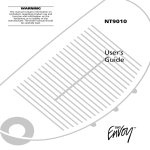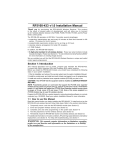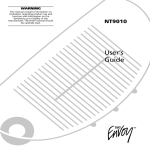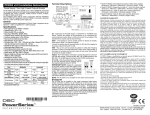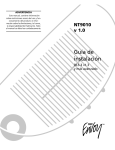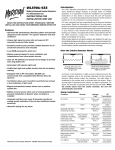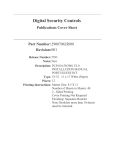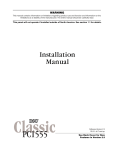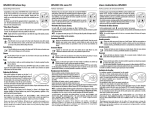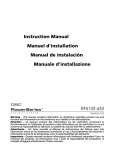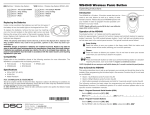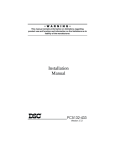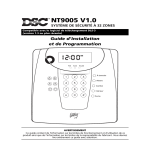Download DSC Envoy NT9005 User Manual
Transcript
NT9005 V1.0 32 ZONE SECURITY SYSTEM Compatible with DLS-3 v1.3 (and higher) downloading software User Guide WARNING: This manual contains information on limitations regarding product use and function and information on the limitations as to liability of the manufacturer. Read the entire manual carefully. Quick Reference Guide The following chart lists the basic functions of your system, and the keys to press for each function. Refer to the listed page number for more information. NOTE: Some functions may not be available on your system. Ask your installer for more information. To Perform This Function: Enter: Page: Turn on system (Away): ..................... [access code], leave through entry/exit door 9 OR press Away (if enabled) Turn on rest of system (if Stay armed): Exit premises when system on: .......... Turn off zones (Bypass): ..................... Test system ........................................ * Turn on system (Quick, if enabled):? .. 9 [access code] 11 * Turn on system (No Entry Time): ........ 0 (from Ready state) 12 * 8 1 OR press Interior (if enabled) 10 * Turn off system:................................. [access code] 0 OR press Exit (if enabled) 12 * 10 1 [two-digit zone number(s)], * Turn on system (Stay):........................ [access code], do not leave premises OR press Stay (if enabled) 6 [master code] 4 # to exit 15 18 Send Fire message: ............................ (press & hold for 2 seconds, if enabled) 14 Send Auxiliary message: .................... (press & hold for 2 seconds, if enabled) 14 Send Panic message: ......................... (press & hold for 2 seconds, if enabled) 14 Silence fire alarm: .............................. [access code] 13 Silence intrusion alarm: ..................... [access code] 14 Turn door chime on/off: ...................... 20 * * Set time and date: ............................. 14 * Check troubles .................................. 3 2 16 * Check alarm memory: ....................... 4 to toggle on or off OR press Chime (if enabled) 6 [master code] 1 20 Table of Co nte nts Quick Reference Guide i Table of Contents ii Limited Warranty iii About This Guide 1 NT9005 Controller Features 2 Section 1: Introduction How Your System Works ................................................ 4 IMPORTANT NOTICE....................................................... 4 Fire Detection ................................................................. 5 Testing ........................................................................... 5 Remote Monitoring ........................................................ 5 Maintenance .................................................................. 5 Section 2: Using Your NT9005 System Operating the System from the NT9005 Controller ......... 6 LCD................................................................................ 6 Section 3: Turning Your System On (Arming) and Off (Disarming) Turning On Your System................................................. 7 Turning Off Your System ................................................ 8 Other Ways to Turn Your System On .............................. 8 Turning On Your System When Everyone is Away (Away Mode).................................................................. 9 What to do if the Siren Sounds Immediately After You Exit................................................................. 9 Turning On Your System While You Are At Home (Stay Mode) .......................................................................... 10 Turning On Your System With No Access Code (Quick Arm).................................................................. 10 Turing On Your System with No Entry Time .................. 11 Turning On Your System Automatically (Automatic Arming) ...................................................... 11 Exiting When the System is On (Quick Exit) ................... 12 Section 4: Dealing With Alarms and Emergencies Fire Alarms ................................................................... 13 Intrusion (Burglary) Alarms............................................ 14 Checking Alarms in Memory......................................... 14 Calling for Help ............................................................ 14 Section 5: Using Advanced Functions Turning Off Part of Your System (Bypassing Zones)...... 15 Checking Trouble Conditions ....................................... 16 Testing Your System..................................................... 18 Allowing Computer Access to Your System .................. 18 Section 6: Customizing Your System Programming Access Codes ......................................... 19 Setting the Time and Date............................................ 20 Turning the Door Chime On or Off............................... 20 Changing the Pitch of the Keypad Tone ....................... 20 Section 7: Fire Safety Household Fire Safety Audit ......................................... 21 Fire Escape Planning..................................................... 21 Section 8: Guidelines for Locating Smoke Detectors 23 Section 9: Replacing Batteries Tips for Buying Batteries............................................... 24 After Installing New Batteries ....................................... 24 Door/Window Contacts................................................ 25 Motion Detectors ......................................................... 25 Glassbreak Detectors.................................................... 26 Smoke Detectors.......................................................... 26 Wireless Keys ............................................................... 26 Glossary . . . . . . . . . . . . . . . . . . . . . . . . . . . . . . . . 27 System Information For Service ................................................................... 29 Access Codes ............................................................... 29 System Information ...................................................... 29 Zone Information ......................................................... 30 Index . . . . . . . . . . . . . . . . . . . . . . . . . . . . . . . . . . 31 Warning . . . . . . . . . . . . . . . . . . . . . . . . . . . . . . . . 32 FCC Compliance Statement. . . . . . . . . . . . . . . . . 33 Industry Canada Statement . . . . . . . . . . . . . . . . 33 i Limited Warranty Digital Security Controls Ltd. warrants the original purchaser that for a period of twelve months from the date of purchase, the product shall be free of defects in materials and workmanship under normal use. During the warranty period, Digital Security Controls Ltd. shall, at its option, repair or replace any defective product upon return of the product to its factory, at no charge for labour and materials. Any replacement and/or repaired parts are warranted for the remainder of the original warranty or ninety (90) days, whichever is longer. The original purchaser must promptly notify Digital Security Controls Ltd. in writing that there is defect in material or workmanship, such written notice to be received in all events prior to expiration of the warranty period. There is absolutely no warranty on software and all software products are sold as a user license under the terms of the software license agreement included with the product. The Customer assumes all responsibility for the proper selection, installation, operation and maintenance of any products purchased from DSC. Custom products are only warranted to the extent that they do not function upon delivery. In such cases, DSC can replace or credit at its option. In t e rn a ti on a l Wa rr an t y The warranty for international customers is the same as for any customer within Canada and the United States, with the exception that Digital Security Controls Ltd. shall not be responsible for any customs fees, taxes, or VAT that may be due. War ra n ty P ro c e du re To obtain service under this warranty, please return the item(s) in question to the point of purchase. All authorized distributors and dealers have a warranty program. Anyone returning goods to Digital Security Controls Ltd. must first obtain an authorization number. Digital Security Controls Ltd. will not accept any shipment whatsoever for which prior authorization has not been obtained. C on di t io n s t o Voi d Wa r ra nt y This warranty applies only to defects in parts and workmanship relating to normal use. It does not cover: • damage incurred in shipping or handling; • damage caused by disaster such as fire, flood, wind, earthquake or lightning; • damage due to causes beyond the control of Digital Security Controls Ltd. such as excessive voltage, mechanical shock or water damage; • damage caused by unauthorized attachment, alterations, modifications or foreign objects; • damage caused by peripherals (unless such peripherals were supplied by Digital Security Controls Ltd.); • defects caused by failure to provide a suitable installation environment for the products; • damage caused by use of the products for purposes other than those for which it was designed; • damage from improper maintenance; • damage arising out of any other abuse, mishandling or improper application of the products. It e m s N o t C o v e re d b y War ra n ty In addition to the items which void the Warranty, the following items shall not be covered by Warranty: (i) freight cost to the repair centre; (ii) products which are not identified with DSC's product label and lot number or serial number; (iii) products disassembled or repaired in such a manner as to adversely affect performance or prevent adequate inspection or testing to verify any warranty claim. Access cards or tags returned for replacement under warranty will be credited or ii replaced at DSC's option. Products not covered by this warranty, or otherwise out of warranty due to age, misuse, or damage shall be evaluated, and a repair estimate shall be provided. No repair work will be performed until a valid purchase order is received from the Customer and a Return Merchandise Authorisation number (RMA) is issued by DSC's Customer Service. Digital Security Controls Ltd.’s liability for failure to repair the product under this warranty after a reasonable number of attempts will be limited to a replacement of the product, as the exclusive remedy for breach of warranty. Under no circumstances shall Digital Security Controls Ltd. be liable for any special, incidental, or consequential damages based upon breach of warranty, breach of contract, negligence, strict liability, or any other legal theory. Such damages include, but are not limited to, loss of profits, loss of the product or any associated equipment, cost of capital, cost of substitute or replacement equipment, facilities or services, down time, purchaser’s time, the claims of third parties, including customers, and injury to property. The laws of some jurisdictions limit or do not allow the disclaimer of consequential damages. If the laws of such a jurisdiction apply to any claim by or against DSC, the limitations and disclaimers contained here shall be to the greatest extent permitted by law. Some states do not allow the exclusion or limitation of incidental or consequential damages, so that the above may not apply to you. D i s c la im e r o f War ra n t ie s This warranty contains the entire warranty and shall be in lieu of any and all other warranties, whether expressed or implied (including all implied warranties of merchantability or fitness for a particular purpose) And of all other obligations or liabilities on the part of Digital Security Controls Ltd. Digital Security Controls Ltd. neither assumes responsibility for, nor authorizes any other person purporting to act on its behalf to modify or to change this warranty, nor to assume for it any other warranty or liability concerning this product. This disclaimer of warranties and limited warranty are governed by the laws of the province of Ontario, Canada. WARNING: Digital Security Controls Ltd. recommends that the entire system be completely tested on a regular basis. However, despite frequent testing, and due to, but not limited to, criminal tampering or electrical disruption, it is possible for this product to fail to perform as expected. I n st al le r ’s Lo c ko u t Any products returned to DSC which have the Installer’s Lockout option enabled and exhibit no other problems will be subject to a service charge. Ou t of Wa rr an t y R e pa ir s Digital Security Controls Ltd. will at its option repair or replace out-of-warranty products which are returned to its factory according to the following conditions. Anyone returning goods to Digital Security Controls Ltd. must first obtain an authorization number. Digital Security Controls Ltd. will not accept any shipment whatsoever for which prior authorization has not been obtained. Products which Digital Security Controls Ltd. determines to be repairable will be repaired and returned. A set fee which Digital Security Controls Ltd. has predetermined and which may be revised from time to time, will be charged for each unit repaired. Products which Digital Security Controls Ltd. determines not to be repairable will be replaced by the nearest equivalent product available at that time. The current market price of the replacement product will be charged for each replacement unit. About This Guide This NT9005 User Guide is designed for anyone using an NT9005 Security System. Read this guide thoroughly to learn how to use your security system. Ensure that all users of this system are fully instructed in its use. Important information about fire and burglary alarms is in Section 4: Dealing With Alarms and Emergencies, beginning on 13. Read this section carefully! * This guide provides step-by-step instructions for each function. Each key you need 4 to turn door chime On/Off). to press will be indicated by its symbol (e.g., To access some functions, you will need to enter your access code (indicated by [access code]). To program other access codes, or to perform advanced functions, you will need to enter your master code (indicated by [master code]). You can also use the master code to turn the system on and off. The NT9005 controller and its lights and functions are described on 2 and 3. The Quick Reference Guide inside the front cover shows you the commands required to access basic system functions, and the page number on which each function is described. See the Glossary on 27 to learn more about special terms used in this manual. Fill out the System Information on 29 and 30 with all of your zone information and access codes, and store this manual in a safe place for future reference. 1 NT9005 controller Features This is the NT9005 controller. It controls and monitors all devices on your NT9005 security system. You can access all system functions using the buttons on the NT9005. Please familiarize yourself with your new system console and its features. 2 ➊ Siren The NT9005 uses the siren to warn you about fire and burglary alarms. ➋ Status Lights The NT9005’s Ready, Armed and Trouble status lights provide instant visual feedback on the status of your security system. Green Ready Light If the Ready light is ON, the system is ready to be turned on. You will not be able to turn the system on unless the Ready light is ON (see Turning On Your System on page 7). Red Armed Light If the Armed light is ON, the system has been turned on successfully. Yellow Trouble Light If the Trouble light is ON, one or more trouble conditions could be present on the system. See Checking Trouble Conditions on page 16. ➌ Emergency Keys: In an emergency, you can use these keys to contact your central station instantly: Press both keys for two seconds to send a Fire message. Press both Keys for two seconds to send an Auxiliary message. Press both Keys for two seconds to send a Panic message. IMPORTANT NOTE: The Fire, Auxiliary and Panic keys will NOT function unless programmed by the installer. If these keys are in service and the installer has enabled audible feedback, holding down both keys for two seconds will cause the keypad sounder to beep indicating that the input has been accepted and sent. ➍ Number Pad Use the number pad to enter your access code and system commands. Press # to exit a function. ➎ Function Buttons If your installer has enabled them, you can use the function buttons to access the Stay, Away, Door Chime, Interior, and Quick Exit features. To use a feature, press and hold one of the buttons for two seconds. Refer to this Guide for more information on these features. 3 Section 1: Introduction Your installer has set up your system with your home or business in mind. You may not need all of the features described in this manual. Your installer will only turn on the features that you need, and should explain all the active features to you. If you have any questions about which features are active on your system, ask your installer. How Your System Works Your security system consists of a DSC NT9005 controller and various wireless devices. The controller is the “brain” of your security system. It controls and checks all the detectors, and communicates with the central station (if remote monitoring is enabled). You will access system functions with your NT9005 controller, which is described on pages 2 and 3 of this manual. Each NT9005 has a siren, number pad, emergency keys, and five function keys. Using the NT9005 keypad you can send commands to the system and check the current system status. Your installer will mount the NT9005 in a convenient location inside your premises. Your security system can provide monitoring of intrusion, fire, and emergency. The security system has several zones (monitored areas). Each of these zones will have a detector (motion detector, glassbreak detector, door contact, etc.). A detector sends signals to the NT9005 which will respond according to programming. IMPORTANT NOTICE 4 A security system cannot prevent emergencies. It is only intended to alert you and – if the system is remotely monitored – your central station of an emergency situation. Security systems are generally very reliable but they may not work under all conditions and they are not a substitute for prudent security practices or life and property insurance. Your security system should be installed and serviced by qualified security professionals who should instruct you on the level of protection that has been provided and on system operations. For important warnings and cautions, see page 32. I n tr o d u c t i o n Fire Detection This NT9005 controller is capable of monitoring fire detection devices such as smoke detectors and providing a warning if a fire condition is detected. Good fire detection depends on having an adequate number of detectors placed in appropriate locations. The system must be installed in accordance with NFPA 72 (N.F.P.A., Batterymarch Park, Quincey MA 02269). Carefully review Fire Safety on page 21. NOTE: Your installer must enable the fire detection portion of this equipment for it to work. Testing To make sure your system continues to work as intended, you must test your system weekly. Please refer to Testing Your System on page 18. If your system does not work correctly, call your installer for service. Remote Monitoring This system can send alarms, troubles and emergency messages over telephone lines to a central station. If you accidentally initiate an alarm, immediately call the central station to prevent an unnecessary response. NOTE: Your installer must enable remote monitoring for it to work. Maintenance With normal use, the system requires minimum maintenance, but please note the following points: 1. Do not wash the security equipment with a wet cloth. Light dusting with a slightly moistened cloth should remove normal dust accumulations. 2. Use the system test described on page 18 to check the battery condition of the NT9005 controller. DSC recommends that the standby battery be replaced every three years. 3. Consult the manufacturer’s literature for testing and maintenance instructions for other system devices such as smoke detectors, motion detectors, and glassbreak detectors. For instructions on replacing detector batteries, see Replacing Batteries on page 24. NOTE: The NT9005 is only compatible with DSC wireless devices. 5 Section 2: Using Your NT9005 System Operating the System from the NT9005 Controller The NT9005 controller provides a large, easy to understand LCD to help you to use your system. You can check the current status of your system by viewing the LCD. The NT9005 will display the time, whether the system is currently on (armed) or off (disarmed), if any zones are currently open or bypassed (turned off), and if there are any trouble conditions currently present on the system. LCD 1 Clock Digits 1, 2 – These two 7 segment clock digits indicate the hour digits when the local clock is active, and identify the zone when the OPEN or ALARM icons are active. These two digits scroll one zone per second from the lowest zone number to the highest when scrolling through zones. 2 : (Colon) – This icon is the hours/minutes divider and will flash once a second when the local clock is active. Clock Digits 3 and 4 – These two clock digits are the minute digits when the local clock is active. 1 to 8 – These icons identify Troubles when [*][2] is pressed. Memory – Indicates that there are alarms in memory. Bypass – Indicates that there are zones automatically or manually bypassed. Fire – Indicates that there are fire alarms in memory. Program – indicates that the system is in Installer’s Programming, or the keypad is busy. 3 4 5 6 7 8 9 Chime – This icon turns on when [*][4] or on the system. Press [*][4] or 10 11 12 13 14 6 Chime is pressed to enable Door Chime Chime to disable Door Chime. AM, PM – This icon indicates that the local clock is displaying 12 Hr. time. These icons will not be on if the system is programmed for 24Hr. time. Away – Indicates that the panel is armed in the Away mode. It will turn on at the beginning of the exit delay. Stay – Indicates that the panel is armed in the Stay mode. It will turn on at the beginning of the exit delay. ALARM – This icon is used with clock digits 1 and 2 to indicate zones in alarm on the system. When a zone is in alarm, the ALARM icon will turn on, and 7 segment displays 1 and 2 will scroll through the zones in alarm. OPEN – This icon is used with clock digits 1 and 2 to indicate violated zones (not alarm) on the system. When zones are opened, the OPEN icon will turn on, and clock digits 1 and 2 will scroll through the violated zones. Section 3: Turning Your System On (Arming) and Off (Disarming) This section describes how to turn your system on and off. Read this section carefully. Turning On Your System 1. Before you turn on your system, make sure that it is Ready. You can tell that the system is ready when the green (Ready) light is ON. If the green light is not on, see the Note below. 2. Enter your access code on the keypad. If you have entered the wrong code, the keypad will sound one long beep - try again to enter the correct code. When you enter a valid access code: • The keypad sounds fast beeps. • The red (Armed) light turns ON. • The keypad starts to beep once every second. This tells you that the system is turning on (Audible Exit Delay). 3. If you will be leaving, go out through the entry/exit door. Doing this tells the system that you are away, and the system turns on completely. If you will be staying, do not open the entry/exit door. This tells the system that you are staying, and the system turns on only the perimeter areas. NOTE: If the green (Ready) light is not ON: • Close all doors and windows • Stop motion in all areas with motion detectors If the yellow (Trouble) light is ON, check for possible trouble conditions (see Checking Trouble Conditions on page 16), and check that no zones are turned off unintentionally (see Turning Off Part of Your System (Bypassing Zones) on page 15). 7 Turning Off Your System 1. If you are outside, enter through the entry/exit door. The keypad beeps to remind you to turn off the system. NOTE: Entering by any other door will immediately cause an alarm. 2. Enter your [access code]. If you have entered from outside, you must enter the correct access code before the keypad stops beeping. If you do not enter a valid access code during this time, the system will sound an alarm. NOTE: If you have entered the wrong code the keypad will sound one long beep - try again to enter the correct code. As soon as you enter the correct code, the red (Armed) light turns OFF and the keypad stops beeping. 3. If an alarm occurred while the system was ON, the NT9005 will display the Memory icon. See Checking Alarms in Memory on page 14. CAUTION: If you return and find that an alarm has occurred while you were away, it is possible that an intruder may still be on the premises. Go to a nearby safe location, and call your central station or the local authorities to investigate. The alarm memory is cleared each time the system is turned on, so any alarms showing have occurred while you were away. Other Ways to Turn Your System On There are two basic methods for turning on your security system. • Away: Use this method when everyone will be away from the premises. See 9. • Stay: Use this method when one or more people will stay on the premises. See 10. You can also use any of the following methods to turn on your system (see pages 10 to 11): • Quick Arming: Turn on your system without having to enter an access code. Your installer must turn on this feature before it will work. • No Entry Arming: Turn on your system with no entry delay time - use this method when no one else will be entering the premises. • Automatic Arming: The system will turn itself on at pre-set times. Your installer must turn on this feature before it will work. 8 T u r n i n g Y o u r S ys te m O n ( A rm i n g ) a n d O f f ( Di s a rm i n g ) Turning On Your System When Everyone is Away (Away Mode) When you turn on your system using the Away method, both interior zones (e.g., motion detectors) and perimeter zones (e.g., door and window contacts) will be active and will cause an alarm if they are opened. 1. Check that your system is ready (green Ready light is ON). 2. Enter your [access code]. As you enter each digit, the keypad sounder beeps. If you entered the access code incorrectly, the keypad sounder buzzes steadily for two seconds. Re-enter your access code correctly. When you enter a valid access code: • The keypad sounds 6 fast beeps. • The red (Armed) light turns ON. • The exit delay time begins and the keypad beeps once every second. The keypad beeps quickly (twice per second) for the last 10 seconds of the exit delay time. 3. Exit the premises through the entry/exit door. Doing this tells the system that you are away, and the system turns on all the interior zones. At the end of the exit delay time, all keypad lights, except the red (Armed) light, turn OFF. The system is now ON. NOTE: If the Bypass icon is ON, there could be one or more zones not turned on. See Turning Off Part of Your System (Bypassing Zones) on page 15. If you turn on the system with a zone bypassed or a trouble present, your security protection is reduced. Away Button You may also be able to turn on your system in Away mode using the Away button on your keypad. Press and hold it for two seconds to turn ON the system in Away mode. Your installer will tell you if this feature has been enabled on your system. What to Do if the Siren Sounds Immediately After You Exit In order to reduce false alarms, the system can notify you of an improper exit when turning on the system in the Away mode. If you do not securely close the entry/exit door during the exit time, the keypad will emit one continuous beep and the siren will sound. If this occurs: 1. Re-enter the premises. 2. Enter your [access code] to turn off the system. You must do this before the entry time ends. 3. Turn the system on again, making sure to close the entry/exit door properly. (See Turning On Your System When Everyone is Away (Away Mode).) 9 Turning On Your System While You Are At Home (Stay Mode) Use the Stay mode when you want to stay at home, and also want to prevent unauthorized entry from outside. The system will only turn on the perimeter zones (e.g., door and window contacts), and will leave the interior zones off (e.g., motion detectors) so that you will be free to move around inside. 1. Check that your system is ready (green Ready light is ON) 2. Enter your [access code]. As you enter each digit, the keypad sounder beeps. If you entered the access code incorrectly, the keypad sounder will buzz steadily for two seconds. Re-enter your access code correctly. When you enter a valid access code: • • • • The keypad sounds 6 fast beeps. The red (Armed) light turns ON. The Bypass message is displayed. The exit delay time begins and the keypad beeps once every second. The keypad will beep twice per second for the last 10 seconds of the exit delay time. 3. DO NOT leave through the entry/exit door. This tells the system that you are not leaving, and the system automatically turns off the interior zones. At the end of the exit delay time, all keypad lights, except the red (Armed) light, will turn OFF. The system is now on. Re-activate bypassed zones To turn on the rest of the system when it is in Stay mode: 1. Press now on. or press the * 1 Interior function key. The interior zones are NOTE: When interior zones are on, you will not be able to enter areas protected by motion detectors, or open doors and windows. To access these areas, you must enter your [access code] and turn off the system. Stay Button Stay funcYou may also be able to Stay arm your system quickly, using the tion button on your keypad. If your installer has programmed this button, press and hold it for two seconds to turn your system on in Stay mode. Your installer will tell you if the Quick Arm method is enabled on your system. If it is, using the following method you can quickly turn on your system without having to enter an access code. 1. Check that the system is ready (green Ready light is ON) 2. Press * Turning On Your System With No Access Code (Quick Arm) 0 . • The keypad sounds 6 fast beeps. • The red (Armed) light turns ON. • The exit delay time begins and the keypad beeps once every second until the end of the exit delay time. 10 T u r n i n g Y o u r S ys te m O n ( A rm i n g ) a n d O f f ( Di s a rm i n g ) 3. Go out through the entry/exit door. The system will be armed in Away mode. If you do not exit, the system will be armed in Stay mode. * 0 will only turn on the system. To turn the system off, NOTE: Pressing you must enter a valid [access code]. See Turning Off Your System on page 8. If you want to turn on the system, and no one else will be entering, you can remove the entry delay time from zones that normally have one. If somebody enters through any zone, the system will sound an instant alarm. 1. Check that your system is ready (green Ready light is ON) 2. Press , then your [access code]. 9 * Turning On Your System with No Entry Delay Time • The red (Armed) light flashes as a reminder that the system is on and has no entry delay time. • The keypad sounds 3 fast beeps. 3. The system is now armed in Stay mode. Your installer may have set up your system to turn on at a pre-set time. If automatic arming has been set up, when the system reaches the pre-set auto-arm time, the keypad buzzers will sound for one minute. During this one-minute warning time, you may be able to stop automatic arming by entering your [access code]. Ask your installer for more information. Your installer may have set up the system so that users with a master code can change the auto-arm time at the keypad. If so, master users will be able to turn the automatic arming function on or off, and program the time at which the system will automatically turn on each day. To turn automatic arming (auto-arm) on or off: , then [master code]. 6 * 1. Press 2. Press 2 to turn automatic arming on or off. The keypad will beep 3 times when auto-arm is turned ON, and will beep one long tone when it is turned OFF. 3. When you are finished, press # . To change the auto-arm time: 1. Press * Turning On Your System Automatically (Automatic Arming) 2. Press 3 3. Press 1 6 , then [master code]. . to 7 to select the day you wish to program (Sunday -Saturday). Enter the auto-arm time using the 24 Hr format (0000 - 2359). For example, to set the time for 1:00pm, enter (1300). 5. When you are finished, press # twice. NOTE: The system must have the correct time and date in order for the auto-arm feature to work. See Setting the Time and Date on page 20. 11 Your installer will tell you if the Quick Exit feature will work on your system. You can use the Quick Exit feature to leave the premises while the system is on, without having to turn your system off and on again. To use the Quick Exit feature: 1. While the system is on, press * Exiting When the System is On (Quick Exit) 0 . 2. The system will start a two minute countdown, during which you may leave through the entry/exit door. NOTE: During this time, you may only open and close the entry/exit door once. Once the door is closed the system will end the two-minute Quick Exit time. If the door is opened again, or is not closed before the two-minutes are up, or if another entry/exit door is opened, the entry delay time will begin. The system must then be turned off so that an alarm is not generated. Exit button Exit function button, press and hold the If your installer has programmed the button for two seconds to activate the Quick Exit feature. 12 Section 4: Dealing With Alarms and Emergencies Read this section carefully so that you will know what to do if your system goes into alarm. If you return to your premises and the siren is on, contact the local authorities from a nearby safe location. Your installer will tell you if fire detection equipment has been installed and enabled on your system. NOTE: A fire alarm always has priority over an intrusion (burglary) alarm. Fire Alarms A pulsing siren means a fire alarm. If there is a fire, or if you are not sure, follow your evacuation plan immediately (see Fire Escape Planning on page 21). If remote monitoring is enabled, the system will send a fire message to the central station. Your installer may have set up the keypad Fire keys and other fire equipment to send a fire alarm message to the central station as soon as they are activated. Your installer may have set up other equipment (e.g., smoke detectors) to have a 30 second delay before sending the alarm message to the central station. Your installer will inform you how the equipment on your system operates. Equipment that has been set up with a 30 second delay (e.g., smoke detectors) gives you time to correct the problem before a false alarm is sent to the central station. If there is no fire condition, to silence the fire alarm: 1. Press # within 30 seconds of the beginning of the alarm. The fire alarm and communication to the central station will be delayed for 90 seconds to give you time to clear the smoke detector. 2. If the detector still detects smoke after 90 seconds, the alarm will sound again. If there is no smoke, the system will return to normal. 3. If you do not press # within the 30 second delay time, the system will send a fire message to the central station (if remote monitoring is enabled on your system). To silence the fire alarm after the 30 second delay has expired, enter your [access code]. NOTE: If you suspect that a fire message has been transmitted, but there is no fire condition, call the central station to avoid an unnecessary response. NOTE: Your installer may have programmed the system to operate differently than described above. Ask your installer for more information regarding your system’s operation. 13 Intrusion (Burglary) Alarms A steady siren means an intrusion alarm. To silence the alarm: 1. Enter your [access code]. 2. If the alarm was unintentional, call your central station immediately to avoid an unnecessary response. 3. Check the alarm memory to see which zone caused the alarm. Once the source of the alarm has been identified and the problem corrected, the system will return to the Ready state. The Memory message will be displayed if there is an alarm in memory. To view zones that have gone into alarm press 3 . The alarm memory is cleared each time the system is turned on. Alarms displayed by the system will have only occurred during the last time the system was on. * Checking Alarms in Memory CAUTION: If you return and find that there was an alarm while you were away, it is possible that an intruder may still be on the premises. Go to a nearby safe location, and call your central station or the local authorities to investigate. Calling for Help The NT9005 has three pairs of emergency keys. Using these keys you can send an immediate Fire, Auxiliary or Panic message to your central station. IMPORTANT: The Fire, Auxiliary and Panic keys will NOT function unless they have been turned ON by the installer. If your installer has turned these keys ON, and enabled audible feedback, holding down the keys for two seconds will cause the keypad sounder to beep indicating that the alarm input has been accepted and transmission to the central station is underway. From the NT9005 controller Press both keys for two seconds to send a Fire message, and to trigger a fire alarm on the system. 14 Press both keys for two seconds to send an Auxiliary message. Press both keys for two seconds to send a Panic message. Section 5: Using Advanced Functions This section describes how to perform more specialized functions: turning off specific detectors (bypassing zones), turning the door chime on or off, checking system troubles, and testing your system. Sometimes, you may need to temporarily turn off one or more detectors (e.g., if you need to go into a protected area while the system is turned on or if a detector is temporarily out of service but you need to turn on the system). This is called “bypassing”. When you bypass a detector, it will not turn on the next time you turn on your system. Detectors (zones) cannot be bypassed once the system is on. Bypasses on detectors are automatically cancelled each time the system is turned off. You must bypass the detectors again, if required, before you turn the system on again. Bypassing a Zone 1. Start with the system turned off. Press * Turning Off Part of Your System (Bypassing Zones) 1 . 2. An [access code] may be required. If it is the the display will go blank. If this happens, enter your [access code]. 3. Enter the two-digit number (01-32) of the detector you want to turn off (bypass). The system will scroll all bypassed detectors. TIP: To find out the number of a detector, check in Zone Information on page 30. 4. To turn a detector back on, enter the two-digit number of the zone (01-32). The system will return the zone to normal status and the zone will be ON when the system is next armed. The system will then scroll all bypassed zones. 5. When you are finished turning off detectors, press # . 6. The next time you turn on your system, the bypassed detectors will not turn on. When you turn your system off again, all zones will return to normal (they will not be bypassed). Bypassing a Group of Zones Two groups of pre-programmed zones can be stored for future use. 1 Bypass all zones you wish to group as described above. 2 Enter 95 to store the zones in group 1 or 96 to store them in group 2. 3 To recall group 1 press 91; to activate group 2 press 92 NOTE: Bypassed detectors will not be able to sound an alarm - this reduces your level of security. If a detector is not working, call a service technician immediately so that the problem can be resolved and your system returned to proper working order. 15 NOTE: For security reasons, your installer may program the system to prevent you from turning off certain detectors (for example, smoke detectors). NOTE: If you have 24-hour zones (zones that are continuously on) on your system, they will stay bypassed until you turn off the bypass using the steps above (ask your installer for more information). Checking Trouble Conditions Your system continuously checks for a number of possible trouble conditions. If one of these trouble conditions occurs: • The yellow (Trouble) light will be ON until the Trouble is corrected. • The keypad will beep twice every 10 seconds until it is acknowledged by press- * ing the # key. • A Trouble condition reduces the level of security your system provides. Call your installing company for service. 2 . To view the Troubles that are present, press To exit the Trouble menu, press # . Here is a list of the various Trouble conditions that may occur: Display: Problem and how it should be addressed: [1] Service required Press [1]. If this number appears, call for service. It represents one or more of the following Troubles: 1 Low Battery Low Battery means the battery voltage has fallen below the normal operating voltage. 2 Not Used 3 General System Indicates that a peripheral device has a system fault. Trouble - NT9204 Supply Trouble. - NT9204 Output Fault. - RF Jam Verified. 4 General System Indicates that a peripheral device has been tampered with. Tamper 5 General System Indicates that a peripheral device can not communicate with the system. Supervisory 16 6 RF Jam RF Jam indicates interference from an RF (Radio Frequency) source. 7 NT9204 Low Battery Indicates that the battery voltage has fallen below the normal operating voltage on the NT9204 module. 8 NT9204 AC Fail Indicates AC voltage failure on the NT9204 module. U s i n g A d v an c e d F u n c t i o n s Display: Problem and how it should be addressed: [2] AC Power Trouble Electrical power to the system has been interrupted. Check your fuse box or circuit breaker to ensure that the electricial supply for the system is on. If this does not correct the problem, call for service. [3] Phone line Trouble Your system has detected a problem with the telephone line. If this problem does not correct itself, or happens frequently, call for service. [4] Communication Trouble Your system has been unsuccessful in communicating an event to your central station. If you get this Trouble, call for service immediately. [5] Your system has detected a fault on one or more zones (detectors). Press 5 , and the system will display which zones have a fault. If you are unsure of how to clear a zone fault, call for service. Zone Fault Press [5] [6] Zone tamper Press [6] Your system has detected a tamper on one or more zones (detectors). Press 6 and the system will display which zone(s) have tampers. If you are unsure how to clear the zone tamper, call for service. [7] Device low battery Press [7] Your system has detected that one or more of the wireless detectors on the system has a low battery. Press 7 , and the system will display which devices have a low battery. Change the relevant batteries. See page 24 for instructions. If this does not correct the problem, call for service. [8] The time and date If all power to the system is interrupted (AC and battery), the system clock and date will need to be reset. See Setting the Time are incorrect and Date on page 20. If you are unsure of the cause of the system power failure, call for service. 17 Testing Your System Test your system every week. Report any problems immediately to your installation company. NOTE: Perform system tests during off-peak hours, such as early morning or late evening. 1. If your system has remote monitoring, call the central station to tell them that you are testing your system. * 6 [Master Code] 4 . The system 2. Begin with the system turned off. Press sounds the siren and turns on all keypad lights for two seconds. When the sounder and keypad test is complete, press # . 3. To test each area of your system, open each door and window in turn, or walk in motion detector areas. 4. View the display to see all open zones. 5. If the system has any fire zones, activation will cause the alarm to sound in a pulsed mode. To silence the alarm, press # . CAUTION: Do not use an open flame or burning materials to test a smoke or heat detector. Contact your installer for information on safe methods of testing detectors. 6. When you are finished testing the system, inform your central station. If the system did not work properly, contact your installer. NOTE: Some features described above will not be functional unless enabled by your installer. Ask your installer which features are functional on your system. Allowing Computer Access to Your System From time to time, your installer may need to send information to, or retrieve information from your security system. Your installer will call your system over the telephone line using a computer. You may need to prepare your system to receive this “downloading” call. To do this: * 6 [Master code] 5 . This allows downloading for 1 or 6 hours 1. Press depending on your installer’s setup. During this time, the system will answer incoming downloading calls. For more information on this feature, ask your installer. 18 Section 6: Customizing Your System This section describes how to customize your system to suit your needs. Refer to this section for detailed instructions on programming access codes and setting time and date. The master code (code 40) can be used to program system options, arm and disarm the system and program other access codes. You can program up to 32 additional access codes (01 through 32). Other access codes, such as system supervisory and duress codes, are available. Contact your installer for more information. * 5 [Master Code]. The red (Armed) light will turn on and the Program1. Press ming icon will be displayed. 2. Enter the two-digit number of the access code you want to program (01-32 for access codes, 33 and 34 for duress codes, 40 for master code, 41 and 42 for supervisor codes). If an access code already exists for the code number you have selected, it will be replaced by the new code. 3. Enter the new code. Access codes must be four digits unless otherwise indicated by your installer. NOTE: Do not use the factory default or obvious codes such as [1111] or [1234]. 4. To exit access code programming, press # . 5. Record your new codes in “System Information” on 29 of this booklet. Access Codes can be custom programmed to limit the options of the user. When a new access code is programmed, it is programmed with the attributes of the code that was used to enter [*] [5] programming (attributes 1,3,7). (1) Arming, disarming, alarm reset allowed. (2) Future Use. (3) Zone Bypassing allowed. (4) Future Use. (7) Bell squawk on arming/disarming. (8) Future use. To change the attributes listed above perform the following: 1. Press * Programming Access Codes 5 [Master Code][9]. 2. Enter the number of the code you want to modify [01 to 32]. The Master code cannot be modfied. 3. Press the digit corresponding to the attribute you wish to remove or add. 19 1. Press * Erasing a code 5 [Master Code] 3. To erase the code, press * 2. Enter the number of the code you want to erase [01 to 32]. The Master code cannot be erased. . 4. To exit access code programming, press . You should make sure that your system has the correct time and date. This is important for the auto-arm feature to function correctly, and for accurate reporting of events. 1. To select time and date, press * Setting the Time and Date # 6 [Master Code] 1 . 2. Enter the time in hours and minutes using the 24 Hour format (00:00 to 23:59) then enter the date in months, days and years (MMDDYY) (November 26, 2000 = 112600). 4. To exit programming, press . If your installer has enabled the door chime feature, your NT9005 will beep whenever designated doors or windows are opened or closed. Your installer has programmed which doors and windows will activate the door chime. 1. Press * Turning the Door Chime On or Off # 4 to turn the door chime feature ON. 2. Press * The keypad will beep 3 times. 4 again to turn the door chime feature OFF. The keypad will sound one long beep. The function button Chime can also perform the same function if it is pressed and held for 2 seconds. When door chime is enabled the keypad will beep 3 times. When door chime is disabled the keypad will sound one long beep. 20 There are several different tones that can be programmed for keypresses and other audible indications. * 1. Press and hold able. Release the . The NT9005 will cycle through the different tones availkey when the tone of your choice sounds. * Changing the Pitch of the Keypad Tone Section 7: Fire Safety Read this section carefully. It contains important information about fire safety. Household Fire Safety Audit Most fires occur in the home. To minimize this danger, we recommend that a household fire safety audit be done and a fire escape plan be created. 1. Are all electrical appliances and outlets in a safe condition? Check for frayed cords, overloaded lighting circuits, etc. If you are uncertain about the condition of your electrical appliances or household service, have a professional evaluate these units. 2. Are all flammable liquids stored safely in closed containers in a well-ventilated, cool area? Cleaning with flammable liquids should be avoided. 3. Are fire-hazardous materials (e.g., matches) well out of reach of children? 4. Are furnaces and wood burning appliances properly installed, clean and in good working order? Have a professional evaluate these appliances. Fire Escape Planning There is often very little time between the detection of a fire and the time it becomes deadly. Therefore it is very important to develop and rehearse a family escape plan. 1. Every family member should participate in developing the escape plan. 2. Study the possible escape routes from each location within the house. Since many fires occur at night, special attention should be given to the escape routes from sleeping quarters. 3. Escape from a bedroom must be possible without opening the interior door. Consider the following when making your escape plans: • Make sure that all exterior doors and windows are easily opened. Ensure that they are not painted shut, and that their locking mechanisms operate smoothly. • If opening or using the exit is too difficult for children, the elderly, or the handicapped, plans for rescue should be developed. This includes making sure that those who are to perform the rescue can promptly hear the fire warning signal. • If the exit is above the ground level, an approved fire ladder or rope should be provided as well as training in its use. • Exits on the ground level should be kept clear. Be sure to remove snow from exterior patio doors in winter. Outdoor furniture or equipment should not block exits. • Each person should know of a predetermined assembly point where everyone can be accounted for (e.g., across the street or at a neighbor’s house). Once everyone is out of the building, call the Fire Department. 21 • A good plan emphasizes a quick escape. Do not investigate or attempt to fight the fire, and do not gather belongings or pets as this wastes valuable time. Once outside, do not re-enter the house. Wait for the fire department. • Write the fire escape plan down and rehearse it frequently so that should an emergency arise, everyone will know what to do. Revise the plan as conditions change, such as the number of people in the home, or if there are changes to the building’s construction. • Make sure your fire warning system is operational by conducting weekly tests (see Checking Trouble Conditions on page 16). If you are unsure about system operation, contact your installing dealer. • We recommend that you contact your local fire department and request further information on fire safety and escape planning. If available, have your local fire prevention officer conduct an in-house fire safety inspection. 22 Section 8: Guidelines for Locating Smoke Detectors Research has shown that all hostile fires in homes generate smoke to a greater or lesser extent. Experiments with typical fires in homes indicate that detectable quantities of smoke precede detectable levels of heat in most cases. For these reasons, smoke alarms should be installed outside of each sleeping area and on each storey of the home. The following information is for general guidance only and it is recommended that local fire codes and regulations be consulted when locating and installing smoke alarms. It is recommended that additional smoke alarms beyond those required for minimum protection be installed. Additional areas that should be protected include: the basement; bedrooms, especially where smokers sleep; dining rooms; furnace and utility rooms; and any hallways not protected by the required units. On smooth ceilings, detectors may be spaced 9.1m (30 feet) apart as a guide. Other spacing may be required depending on ceiling height, air movement, the presence of joists, uninsulated ceilings, etc. Consult National Fire Alarm Code NFPA 72, CAN/ULC-S553-M86 or other appropriate national standards for installation recommendations. Do not locate smoke detectors at the top of peaked or gabled ceilings; the dead air space in these locations may prevent the unit from detecting smoke. Avoid areas with turbulent air flow, such as near doors, fans or windows. Rapid air movement around the detector may prevent smoke from entering the unit. Do not locate detectors in areas of high humidity. Do not locate detectors in areas where the temperature rises above 38oC (100oF) or falls below 5oC (41oF). Smoke detectors should always be installed in accordance with NFPA 72, the National Fire Alarm Code. Smoke detectors should always be located in accordance with: • Paragraph 2-2.1.1.1 of NFPA 72, Chapter 2: ‘Smoke detectors shall be installed outside of each separate sleeping area in the immediate vicinity of the bedrooms and on each additional storey of the family living unit, including basements and excluding crawl spaces and unfinished attics. In new construction, a smoke detector also shall be installed in each sleeping room’. • Paragraph 2-2.1.1.2 of NFPA 72, Chapter 2: ’Split level arrangement: Smoke detectors are required where shown. Smoke detectors are optional where a door is not provided between living room and recreation room’. 23 Section 9: Replacing Batteries From time to time, the batteries in the detectors and other components of your system will need to be changed. If a device has a low battery, your system will display a trouble message (see Checking Trouble Conditions on page 16). When the batteries in one device need to be replaced, it is suggested that the batteries in all system devices be replaced at the same time. The batteries used in the devices are Eveready Alkaline Energizer or Energizer Lithium batteries. NOTE: Before changing the batteries in the detectors, you should inform your central station. Tips for Buying Batteries • Your system is designed to work with either Eveready Alkaline Energizer or Lithium batteries according to the individual device. When replacing batteries, be sure to buy the same brand and type. Do not replace the batteries with any other type. The reliability of your security system depends on its batteries, and “no name” or generic brand batteries may not provide the best quality and dependability. • Use fresh batteries. Most batteries have a “best before” date printed on their packaging or on the batteries themselves. Buy batteries that have a “best before” date of two years or more from your purchase date. • When disposing of used batteries, follow the instructions and precautions printed on the batteries. Many cities and communities have collection sites or disposal services. Contact your municipal offices for more information. • If in doubt about the batteries used in your system, or if you have trouble installing them, contact your installer for assistance. Required Batteries After Installing New Batteries 24 WLS904P-433 Pet-Immune Motion Detector Four AAA batteries. WLS904PL-433 Pet-Immune Motion Detector Two Lithium Energizer No. EL123AP batteries. WLS906-433 Wireless Smoke Detector Six AA batteries. WLS909-433 Wireless Key Three Energizer No. LR44 batteries. WLS919-433 Wireless Key Two Lithium Energizer No. CR2032 batteries. WLS912-433 Wireless Glassbreak Detector Three AA batteries. WLS912L-433 Wireless Glassbreak Detector Two Lithium Energizer No. EL123AP batteries. WLS914-433 Pet-Immune Motion Detector Four AA batteries. WLS907T-433 Universal Transmitter Three AAA batteries. WLS925L-433 Universal Transmitter One Lithium Energizer No. EL123AP battery. After you change the batteries on your system, the system may display trouble conditions. A zone tamper should be displayed for each detector that had batteries changed. A zone fault may also be displayed for these detectors. Refer to Checking Trouble Conditions on page 16 for information on checking zone faults and zone tampers. Be sure to perform a complete test of your system after new batteries are installed to ensure that all detectors are working properly (see Testing Your System on page 18). R e p l a c i n g B at te r i e s Door/Window Contacts WLS907T-433 Insert a small screwdriver into the slot on the side of the sensor. Push the screwdriver in and lift off the cover. Remove the old batteries and install three fresh Eveready Alkaline Energizer AAA batteries. Insert the batteries, ensuring that the correct polarity is observed. Carefully replace the cover. WLS925L-433 To remove the cover of the universal transmitter, insert a small flat blade screw driver into the notches and gently pry open the cover. Pull to release the cover. Use care when installing the battery and observe the correct polarity (see diagram). Use only an Eveready Lithium Energizer No. EL123AP battery. Caution: Do NOT touch the coiled antenna on the unit. This can result in improper operation. Motion Detectors WLS904P-433 Remove the motion detector from its mounting plate by holding the detector by its sides and pushing up. Remove the old batteries and install four fresh Eveready Alkaline Energizer AAA batteries. Be sure to observe correct polarity when inserting the batteries. Replace the detector on its mounting plate, making sure it snaps into place. WLS904PL-433 Remove the motion detector from its mounting plate by holding the detector by its sides and pushing up. Remove the old batteries and install two fresh Eveready Lithium Energizer EL123AP batteries. Observe correct polarity when inserting the batteries. Replace the detector on the mounting plate, making sure it snaps into place. WLS914-433 Remove the motion detector from its mounting plate by holding the sensor by its sides and pushing up. Install four fresh Eveready Alkaline Energizer AA batteries. Be sure to insert the batteries in the proper orientation. Replace the sensor on its mounting plate, making sure it snaps into place. After the batteries are installed, the detector will take 60 seconds to warm up. During this time the LED will flash. 2 x 3V LITHIUM BATTERIES 25 Glassbreak Detectors WLS912-433 Remove the detector from its mounting plate by pushing the detector in the direction indicated. Install the three Energizer AA batteries, observing the correct polarity, as shown below. WLS912L-433 Remove the detector from its mounting plate by pushing the detector in the direction indicated. Install the two Lithium batteries, observing the correct polarity, as shown below. Smoke Detectors WLS906-433 The WLS906-433 requires six Eveready Energizer AA batteries. To replace the batteries, remove the detector from the mounting plate by pushing the locking tab and turning the detector counter-clockwise. Hold the unit with the battery compartment facing you, and the imprinted wording right-side up. Install the first two batteries in the row nearest to you, with the + terminals facing left. Next, install the middle two batteries with the + terminals facing to the right. Place your thumb over the centre of these four batteries to keep them in place. Install the last two batteries, with their + terminals facing to the left, by snapping them past the nylon retainer. Wireless Keys WLS909-433 The WLS909-433 requires three Energizer LR44 batteries. To replace the batteries, remove the screw on the back of the key and carefully separate the two sides of the key’s plastic casing. Remove the old batteries from the two metal clips. Insert the new batteries according to the diagram at right and reattach the two sides of the key’s plastic casing. Battery polarity must be observed WLS919-433 The WLS919-433 wireless key requires two lithium CR2032 batteries. To replace the batteries, open the key’s plastic housing by inserting a flathead screwdriver along the side of the unit and carefully twist the screwdriver to separate the top and bottom plastic. Once separated the batteries will be visible; remove the old batteries and insert the new ones. 26 + + Glossary Access code A 4 or 6-digit code you enter on the keypad to turn your system on or off, or to use other system features. Alarm When a zone is violated (e.g., a smoke detector detects smoke, a motion detector senses movement, a door with a contact is opened), it will trigger an alarm. Intrusion (burglary) alarm: An alarm triggered by an intrusion detector (e.g., motion detectors, glassbreak detectors, door/window contacts). Usually occurs when the system is on. Intrusion alarms sound with a steady siren. Fire alarm: An alarm triggered by fire, smoke or heat detectors. Fire alarms may be triggered at any time, whether the system is on or off. Fire alarms sound with a pulsing siren. Audible exit fault A feature that warns you of an improper exit (e.g., door not completely shut) when you attempt to turn on your system. Helps to prevent false alarms. Away arming Turning on the system so that all the detectors (perimeter and interior) are on. (Used when everyone is away from the premises.) Bypassing a zone Turning off a detector temporarily. When you bypass a zone, the detector for that zone will not monitor activity in the zone and will not be able to trigger an alarm until the system has been turned off, then on again. Central station If remote monitoring is enabled, your system will send alarms, troubles and emergency messages to the central station. If necessary, the central station will then notify authorities in your area. Detector A part of the system that can detect and report problems (e.g., a motion detector can tell if there is movement in a room). Emergency message A message sent to the central station when one of the 3 pairs of emergency keys ( ) is pressed and held for two seconds. Your installer must program these keys, or they will not work. Entry delay time A timer programmed by your installer. It starts when you enter an area of the system that is on. You must enter an access code to turn the system off before the timer runs out, or else an alarm will be triggered. 27 Entry/exit doors Your installer will program the doors you usually use to enter or exit the premises as the entry/exit doors. These doors are programmed with entry and exit delay times so that you can turn the system on and off without causing a false alarm. Exit delay time A timer programmed by your installer. It starts when you turn on your system to allow you a period of time to leave the premises. At the end of the exit delay time, the system will be on. Master code The master code 4- or 6- digit access code, is used to set system options, to turn the system on and off, and to program other access codes. Stay mode Turning on the system so that only the perimeter zones (see zone definitions, below) are on. (Use when one or more people will stay on the premises.) Trouble The NT9005 controller continuously checks the system for problems. If the controller finds a problem (trouble), it will indicate this at the keypad. See Checking Trouble Conditions on page 16 for a list of possible trouble conditions, and how they are displayed. Zone A limited area of the premises monitored by a detector (smoke detector, door/window contact, motion detector, glassbreak detector, etc.). Perimeter zone: A zone that detects intrusion from outside the premises (e.g., door contact on an outside door, glassbreak detector). Interior zone: A zone that detects intruders who have already entered (e.g., a motion detector). Fire zone: A zone that has a heat or smoke detector. 28 System Information Fill out the following information for future reference and store this guide in a safe space. For Service Central Station Information: Account #:_______________________________ Telephone #: ____________________________ Installer Information: Company: _______________________________ Telephone #: ____________________________ ________________________________________ ________________________________________ Access Codes Your Master Code is: _____________________________ Your Supervisor Code #1 is: _______________________ Your Supervisor Code #2 is: _______________________ Additional Access Codes: Code # Access Code Code # Access Code Code # Access Code Code # 01 09 17 25 02 10 18 26 03 11 19 27 04 12 20 28 05 13 21 29 06 14 22 30 07 15 23 31 08 16 24 32 Access Code System Information [F] FIRE _____________________________________ [A] AUXILIARY_______________________________ [P] PANIC ___________________________________ The Exit Time is______________________ seconds. The Entry Time is ____________________ seconds. 29 Zone Information There are ________ active zones on the system. Zone 30 Protected Area Zone Type Zone 01 17 02 18 03 19 04 20 05 21 06 22 07 23 08 24 09 25 10 26 11 27 12 28 13 29 14 30 15 31 16 32 Protected Area Zone Type Index A AC power trouble message 17 Access codes adding 19 changing 19 defined 27 Master code 28 programming 19 Alarm checking 14 defined 27 false 13 fire 13 intrusion 14 memory 14 Armed light 3 turning off system 8 turning on system 7 Arming automatic 11 away 9 basic 7 no entry delay 11 quick 10 stay 10 Automatic arming 11 Auxiliary keys 14 Away 9 B Batteries 24 Burglary alarm 14 Buttons see Function buttons Bypassing zones 15 C Central station 5 defined 27 Checking alarms 14 troubles 16 Chime 20 Cleaning the system 5 Codes See Access codes Communication trouble message 17 Computer access to system 18 D Date setting 20 Detectors defined 27 See also Zones Device low battery message 17 Disarming 8 Door chime 20 entry/exit 7, 9, 28 Door/window contacts 25 Downloading 18 E Emergency keys 14 Entry time 8 defined 27 Entry/exit door defined 28 Exit 12 Exit time 9 defined 28 F False alarm 13 Fire alarm 13 detection 5 escape planning 21 keys 14 safety 21 Function buttons 3, 6, 9, 10, 12, 20 G Glassbreak detectors 26 I Intrusion alarm 14 M Maintenance of system 5 Master code 28 Monitoring station 5 Motion detectors 25 O Operating the system 6 P Panic keys 14 Phone line trouble message 17 Problem, See Trouble Programming automatic arming 11 codes 19 time and date 20 Q Status 6 Stay 10 System how it works 4 maintenance 5 operating 6 testing 5, 18 trouble 16 turning off 8 turning on 7 Trouble light 3 programming codes 19 trouble 16 turning on system 9 T Testing 5, 18 Time setting 20 Time and date trouble 17 Trouble defined 28 messages 16 Turning off system See Disarming Turning on system See Arming Quick arming 10 exit 12 W R Zone fault 24 message 17 Zone tamper 24 message 17 Zones bypassing 15 defined 28 testing 18 Ready light 3 turning on system 7 Remote monitoring 5 Replacing batteries 24 S Service is required trouble 16 Smoke detectors 26 Siren 3 Changing pitch 20 Wireless keys 26 Z 31 WARNING Please Read Carefully N o te to In s t a ller s This warning contains vital information. As the only individual in contact with system users, it is your responsibility to bring each item in this warning to the attention of the users of this system. Sy st e m Fa i l u re s This system has been carefully designed to be as effective as possible. There are circumstances, however, involving fire, burglary, or other types of emergencies where it may not provide protection. Any alarm system of any type may be compromised deliberately or may fail to operate as expected for a variety of reasons. Some but not all of these reasons may be: ■ Inadequate Installation A security system must be installed properly in order to provide adequate protection. Every installation should be evaluated by a security professional to ensure that all access points and areas are covered. Locks and latches on windows and doors must be secure and operate as intended. Windows, doors, walls, ceilings and other building materials must be of sufficient strength and construction to provide the level of protection expected. A reevaluation must be done during and after any construction activity. An evaluation by the fire and/or police department is highly recommended if this service is available. ■ Criminal Knowledge This system contains security features which were known to be effective at the time of manufacture. It is possible for persons with criminal intent to develop techniques which reduce the effectiveness of these features. It is important that a security system be reviewed periodically to ensure that its features remain effective and that it be updated or replaced if it is found that it does not provide the protection expected. ■ Access by Intruders Intruders may enter through an unprotected access point, circumvent a sensing device, evade detection by moving through an area of insufficient coverage, disconnect a warning device, or interfere with or prevent the proper operation of the system. ■ Every fire is different in the amount of smoke produced and the rate of burning. Smoke detectors cannot sense all types of fires equally well. Smoke detectors may not provide timely warning of fires caused by carelessness or safety hazards such as smoking in bed, violent explosions, escaping gas, improper storage of flammable materials, overloaded electrical circuits, children playing with matches or arson. Even if the smoke detector operates as intended, there may be circumstances when there is insufficient warning to allow all occupants to escape in time to avoid injury or death. ■ Motion Detectors Motion detectors can only detect motion within the designated areas as shown in their respective installation instructions. They cannot discriminate between intruders and intended occupants. Motion detectors do not provide volumetric area protection. They have multiple beams of detection and motion can only be detected in unobstructed areas covered by these beams. They cannot detect motion which occurs behind walls, ceilings, floor, closed doors, glass partitions, glass doors or windows. Any type of tampering whether intentional or unintentional such as masking, painting, or spraying of any material on the lenses, mirrors, windows or any other part of the detection system will impair its proper operation. Passive infrared motion detectors operate by sensing changes in temperature. However their effectiveness can be reduced when the ambient temperature rises near or above body temperature or if there are intentional or unintentional sources of heat in or near the detection area. Some of these heat sources could be heaters, radiators, stoves, barbeques, fireplaces, sunlight, steam vents, lighting and so on. ■ Warning Devices Warning devices such as sirens, bells, horns, or strobes may not warn people or waken someone sleeping if there is an intervening wall or door. If warning devices are located on a different level of the residence or premise, then it is less likely that the occupants will be alerted or awakened. Audible warning devices may be interfered with by other noise sources such as stereos, radios, televisions, air conditioners or other appliances, or passing traffic. Audible warning devices, however loud, may not be heard by a hearing-impaired person. Power Failure controllers, intrusion detectors, smoke detectors and many other security devices require an adequate power supply for proper operation. If a device operates from batteries, it is possible for the batteries to fail. Even if the batteries have not failed, they must be charged, in good condition and installed correctly. If a device operates only by AC power, any interruption, however brief, will render that device inoperative while it does not have power. Power interruptions of any length are often accompanied by voltage fluctuations which may damage electronic equipment such as a security system. After a power interruption has occurred, immediately conduct a complete system test to ensure that the system operates as intended. ■ Telephone Lines ■ ■ Component Failure Failure of Replaceable Batteries This system’s wireless transmitters have been designed to provide several years of battery life under normal conditions. The expected battery life is a function of the device environment, usage and type. Ambient conditions such as high humidity, high or low temperatures, or large temperature fluctuations may reduce the expected battery life. While each transmitting device has a low battery monitor which identifies when the batteries need to be replaced, this monitor may fail to operate as expected. Regular testing and maintenance will keep the system in good operating condition. ■ Compromise of Radio Frequency (Wireless) Devices Signals may not reach the receiver under all circumstances which could include metal objects placed on or near the radio path or deliberate jamming or other inadvertent radio signal interference. ■ System Users A user may not be able to operate a panic or emergency switch possibly due to permanent or temporary physical disability, inability to reach the device in time, or unfamiliarity with the correct operation. It is important that all system users be trained in the correct operation of the alarm system and that they know how to respond when the system indicates an alarm. ■ Smoke Detectors Smoke detectors that are a part of this system may not properly alert occupants of a fire for a number of reasons, some of which follow. The smoke detectors may have been improperly installed or positioned. Smoke may not be able to reach the smoke detectors, such as when the fire is in a chimney, walls or roofs, or on the other side of closed doors. Smoke detectors may not detect smoke from fires on another level of the residence or building. If telephone lines are used to transmit alarms, they may be out of service or busy for certain periods of time. Also an intruder may cut the telephone line or defeat its operation by more sophisticated means which may be difficult to detect. ■ Insufficient Time There may be circumstances when the system will operate as intended, yet the occupants will not be protected from the emergency due to their inability to respond to the warnings in a timely manner. If the system is monitored, the response may not occur in time to protect the occupants or their belongings. Although every effort has been made to make this system as reliable as possible, the system may fail to function as intended due to the failure of a component. ■ Inadequate Testing Most problems that would prevent an alarm system from operating as intended can be found by regular testing and maintenance. The complete system should be tested weekly and immediately after a break-in, an attempted break-in, a fire, a storm, an earthquake, an accident, or any kind of construction activity inside or outside the premises. The testing should include all sensing devices, keypads, consoles, alarm indicating devices and any other operational devices that are part of the system. ■ Security and Insurance Regardless of its capabilities, an alarm system is not a substitute for property or life insurance. An alarm system also is not a substitute for property owners, renters, or other occupants to act prudently to prevent or minimize the harmful effects of an emergency situation. FCC COMPLIANCE STATEMENT CAUTION: Changes or modifications not expressly approved by Digital Security Controls Ltd. could void your authority to use this equipment. This equipment has been tested and found to comply with the limits for a Class B digital device, pursuant to Part 15 of the FCC Rules. These limits are designed to provide reasonable protection against harmful interfer-ence in a residential installation. This equipment generates, uses and can radiate radio frequency energy and, if not installed and used in accordance with the instructions, may cause harmful interference to radio communications. However, there is no guarantee that interference will not occur in a particular installation. If this equipment does cause harmful interference to radio or television reception, which can be deter-mined by turning the equipment off and on, the user is encouraged to try to correct the interference by one or more of the following measures: • Re-orient the receiving antenna. • Increase the separation between the equipment and receiver. • Connect the equipment into an outlet on a circuit different from that to which the receiver is connected. • Consult the dealer or an experienced radio/television technician for help. The user may find the following booklet prepared by the FCC useful: "How to Identify and Resolve Radio/Television Interference Problems". This booklet is available from the U.S. Government Printing Office, Wash-ington D.C. 20402, Stock # 004-000-00345-4. IMPORTANT INFORMATION This equipment complies with Part 68 of the FCC Rules. On the side of this equipment is a label that contains, among other information, the FCC registration number and ringer equivalence number (REN) for this equipment. If requested, this number must be provided to the Telephone Company. FCC Registration Number: F53CAN-36358-AL-E REN: 0.1B USOC Jack: RJ-31X Telephone Connection Requirements A plug and jack used to connect this equipment to the premises wiring and telephone network must comply with the applicable FCC Part 68 rules and requirements adopted by the ACTA. A compliant telephone cord and modular plug is provided with this product. It is designed to be connected to a compatible modular jack that is also compliant. See installation instructions for details. Ringer Equivalence Number (REN) The REN is used to determine the number of devices that may be connected to a telephone line. Excessive RENs on a telephone line may result in the devices not ringing in response to an incoming call. In most but not all areas, the sum of RENs should not exceed five (5.0). To be certain of the number of devices that may be connected to a line, as determined by the total RENs, contact the local Telephone Company. For products approved after July 23, 2001, the REN for this product is part of the product identifier that has the format US: AAAEQ##TXXXX. The digits represented by ## are the REN without a decimal point (e.g., 03 is a REN of 0.3). For earlier products, the REN is separately shown on the label. AVIS: L’étiquette de l’Industrie Canada identifie le matériel homologué. Cette étiquette certifie que le matériel est conforme à certaines normes de protection, d’exploitation et de sécurité des réseaux de télécommunications. Industrie Canada n’assure toutefois pas que le matériel fonctionnera à la satisfaction de l’utilisateur. Avant d’installer ce matériel, l’utilisateur doit s’assurer qu’il est permis de le raccorder aux installations de l’entreprise locale de télécommunication. Le matériel doit également être installé en suivant une méthode acceptée de raccordement. L’abonné ne doit pas oublier qu’il est possible que la conformité aux conditions énoncées ci-dessus n’empêchent pas la dégradation du service dans certaines situations. Les réparations de matériel homologué doivent être effectuées par un centre d’entretien canadien autorisé désigné par le fournisseur. La compagnie de télécommunications peut demander à l’utilisateur de débrancher un appareil à la suite de réparations ou de modifications effectuées par l’utilisateur ou à cause de mauvais fonctionnement. Pour sa propre protection, l’utilisateur doit s’assurer que tous les fils de mise à la terre de la source d’énergie électrique, les lignes téléphoniques et les canalisations d’eau métalliques, s’il y en a, sont raccordés ensemble. Cette précaution est particulièrement importante dans les régions rurales. AVERTISSEMENT: L’utilisateur ne doit pas tenter de faire ces raccordements lui-même; il doit avoir recours à un service d’inspection des installations électriques, ou à un électricien, selon le cas. L’indice de charge (IC) assigné a chaque dispositif terminal indique, pour éviter toute surcharge, le pourcentage de la charge totale qui peut être raccordée à un circuit téléphonique bouclé utilisé par ce dispositif. La terminaison du circuit bouclé peut être constituée de n’importe quelle combinaison de dispositifs, pourvu que la somme des indices de charge de l’ensemble des dispositifs ne dépasse pas 100. L’Indice de charge de ce produit est 0.4B. Incidence of Harm If the NT9005 equipment causes harm to the telephone network, the telephone company will notify you in advance that temporary discontinuance of service may be required. But if advance notice is not practical, the Telephone Company will notify the customer as soon as possible. Also, you will be advised of your right to file a complaint with the FCC if you believe it is necessary. Changes in Telephone Company Equipment or Facilities The Telephone Company may make changes in its facilities, equipment, operations or procedures that could affect the operation of the equipment. If this happens the Telephone Company will provide advance notice in order for you to make necessary modifications to maintain uninterrupted service. Equipment Maintenance Facility If trouble is experienced with this equipment NT9005 for repair or warranty information, please contact the facility indicated below. If the equipment is causing harm to the telephone network, the Telephone Company may request that you disconnect the equipment until the problem is solved. This equipment is of a type that is not intended to be repaired by the end user. Simplex Time Recorder Co. 100 Simplex Drive, Westminster MA 01441-0001 USA, Tel: (978) 731-2500 Additional Information Connection to party line service is subject to state tariffs. Contact the state public utility commission, public service commission or corporation commission for information. Alarm dialing equipment must be able to seize the telephone line and place a call in an emergency situation. It must be able to do this even if other equipment (telephone, answering system, computer modem, etc.) already has the telephone line in use. To do so, alarm dialing equipment must be connected to a properly installed RJ-31X jack that is electrically in series with and ahead of all other equipment attached to the same telephone line. Proper installation is depicted in the figure below. If you have any questions concerning these instructions, you should consult your telephone company or a qualified installer about installing the RJ-31X jack and alarm dialing equipment for you. Customer Premises Equipment and Wiring Network Service Provider's Facilities Computer RJ-31X Jack Alarm Dialing Equipment Unused RJ-11 Jack Telephone Line Telephone Network Demarcation Point Telephone Fax Machine Answering System Unused RJ-11 Jack Telephone NOTICE: The Industry Canada label identifies certified equipment. This certification means that the equipment meets certain telecommunications network protective, operational and safety requirements. Industry Canada does not guarantee the equipment will operate to the user’s satisfaction. Before installing this equipment, users should ensure that it is permissible to be connected to the facilities of the local telecommunications company. The equipment must also be installed using an acceptable method of connection. The customer should be aware that compliance with the above conditions may not prevent degradation of service in some situations. Repairs to certified equipment should be made by an authorized Canadian maintenance facility designated by the supplier. Any repairs or alterations made by the user to this equipment, or equipment malfunctions, may give the telecommunications company cause to request the user to disconnect the equipment. User should ensure for their own protection that the electrical ground connections of the power utility, telephone lines and internal metallic water pipe system, if present, are connected together. This precaution may be particularly important in rural areas. CAUTION: Users should not attempt to make such connections themselves, but should contact the appropriate electric inspection authority, or electrician, as appropriate. The Load Number (LN) assigned to each terminal device denotes the percentage of the total load to be connected to a telephone loop which is used by the device, to prevent overloading. The termination on a loop may consist of any combination of devices subject only to the requirement that the total of the Load Numbers of all the devices does not exceed 100. The Load Number of this unit is 0.4B. This Class B digital apparatus meets all requirements of the Canadian interference-causing equipment regulations. Cet appareil numérique de la Classe B respecte toutes les exigences de règlement sur le matériel brouilleur du Canada. NOTES NOTES ©2001 Digital Security Controls Ltd. Toronto • Canada • www.dsc.com Printed in Canada 29034463 R001








































